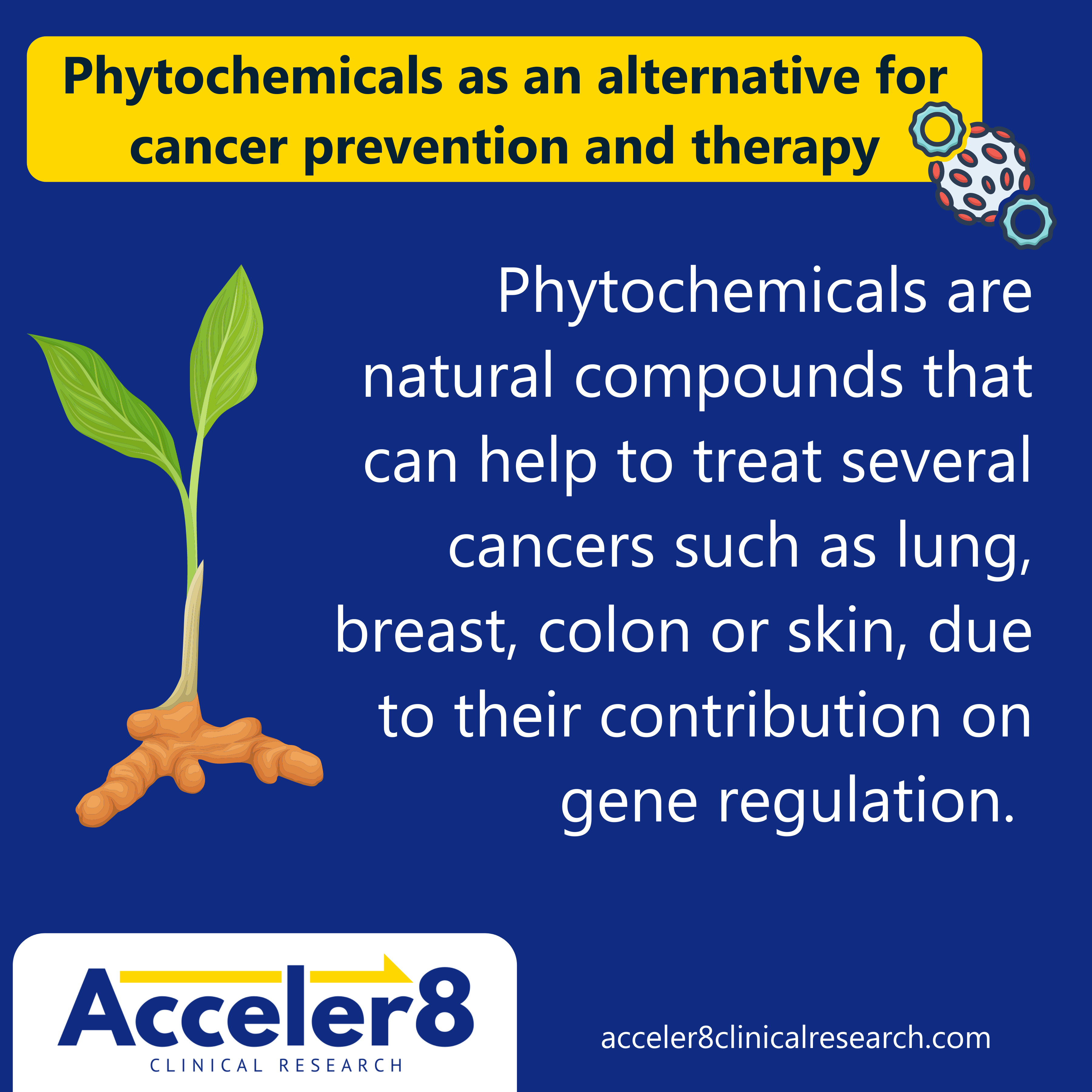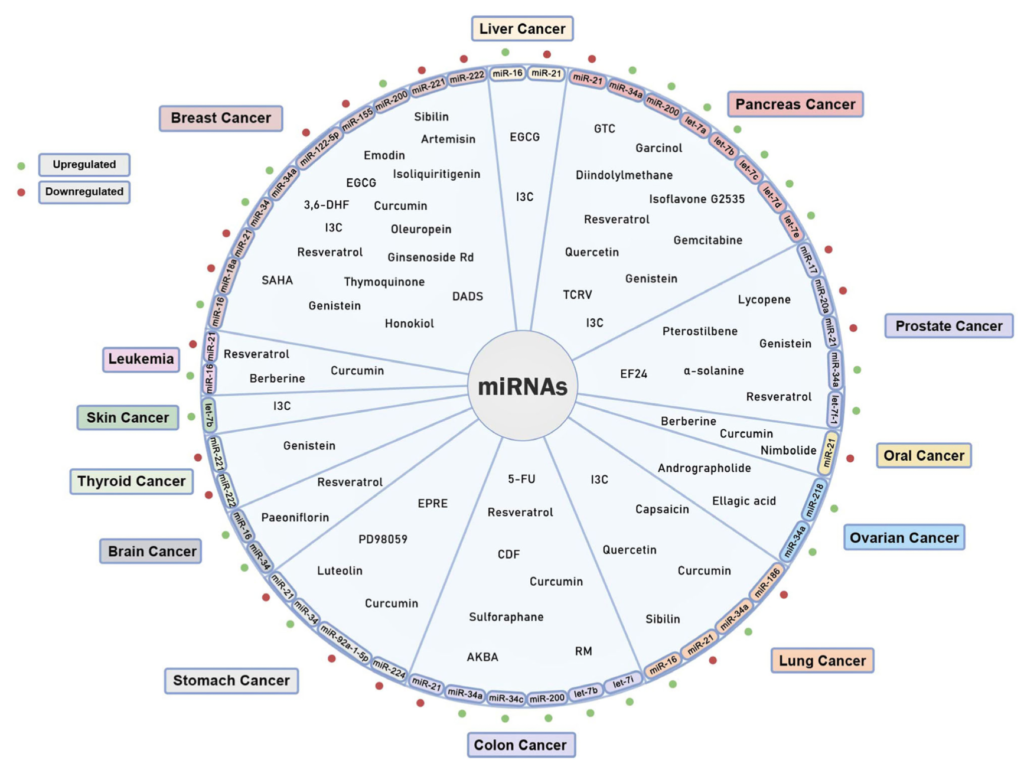
Source: Ruiz-Manriquez, L. M., Estrada-Meza, C., Benavides-Aguilar, J. A., Ledesma-Pacheco, S. J., Torres-Copado, A., Serrano-Cano, F. I., Bandyopadhyay, A., Pathak, S., Chakraborty, S., Srivastava, A., Sharma, A., & Paul, S. (2021). Phytochemicals mediated modulation of microRNAs and long non-coding RNAs in cancer prevention and therapy. Phytotherapy Research, 1– 25. https://doi.org/10.1002/ptr.7338
Cancer prevention and treatment have been a challenge for decades to pharmaceutical and biotechnological companies. This disease is one of the deadliest chronic disorders since one-sixth of the deaths globally are caused by cancer, being the deadliest type the lung cancer, with 1.76 million deaths per year. Additionally, only in 2018, about 18.1 million cases of cancer were diagnosed, and the International Agency for Research on Cancer expects that the new cancer diagnoses rise to 29.5 million by 2040.
The fact that cancer is very complex in many aspects has led to having few treatments with relatively little success, such as radiation therapy or systematic chemotherapy. The limited options of treatments also cause that the financial impact of cancer to be very significant, since, for example, the cumulative economic cost for cancer in 2010 was 1.16 trillion USD. Therefore, it is imperative to look for alternative treatments for this disease, a challenge in which clinical research is very involved and interested.
Some of the alternative treatments for cancer involve the use of several phytochemical compounds, which are defined as plant-derived metabolites that can be found in many fruits, herbs, and vegetables. The most common phytochemicals are polyphenols, terpenoids, alkaloids, and organosulfur compounds, which have been even used to treat several types of cancers in a traditional medicine approach.

Phytochemicals mediated regulation of miRNAs in different cancers. Red (downregulated) and green (upregulated) dots indicate differential expression of each miRNA (Ruiz-Manríquez et al., 2021).
The effect of phytochemicals on cancer treatment relies on the fact that these compounds can alter the expression of molecules such as microRNAs (miRNA or miR), which are endogenous, short, non-coding RNA molecules that are crucial for gene regulation. miRNAs interact with messenger RNA (mRNA) thanks to their complementarity, which can have two scenarios: if there is a partial interaction of the miRNA with the target mRNA, the result is translational repression, meaning that protein cannot be produced, while a complete complementarity leads to mRNA degradation.
For example, the overexpression of miR-21 has been related to several types of cancer, such as lung, stomach, prostate, breast, or colon, where this molecule targets tumor suppressor genes such as the phosphate and tensin homolog (PTEN) or the programmed cell death 4 (PDCD4). It has been found that curcumin, a yellow polyphenol found in Curcuma longa can reduce the expression of miR-21 in colon cancer cells leading to reduced tumor growth and metastasis, by increasing the expression of the PDCD4 gene. Also, it has been observed that curcumin presents proapoptotic and antiproliferative properties in human non-small-cell lung cancer cells, mediated by PTEN upregulation caused due to the inhibition of miR-21.
Another example of the miRNA-phytochemical interaction can be observed with luteolin and miR-224. Luteolin is a phytochemical that has an important role in the regulation of gastric cancer cell migration, proliferation, and invasion, while miR-224 is one of the most common cancer-associated miRNAs since its anomalous expression leads to the development of tumorigenesis. It has been reported that luteolin can inhibit the expression of proteins such as MMP-2, MMP-9, vimentin, cyclin D1, cyclin E, and Bc12 due to the downregulation of miR-224, leading to processes such as the apoptosis of gastric cancer cells.
Additionally, breast cancer, which is one of the most common types of cancer, has been related to oleuropein, an olive-derived polyphenol that can help to downregulate miR-155 expression and lead to increased apoptosis. The main target gene of miR-155 is TP53INP1, which is known to play a significant role in cell cycle arrest and p53-mediated apoptosis.
Phytochemicals can also help to increase the expression of tumor suppressor miRNAs, such as the miR-34 family, which has been related to ailments such as colorectal and breast cancer. Resveratrol, a polyphenolic antioxidant found in grapes, red wine, and peanuts can inhibit the cell viability and promote apoptosis of colorectal cancer cell lines such as HCT-116 and HT-29, by upregulating the expression of miR-34c. Also, resveratrol can suppress the proliferation of breast cancer cell lines by upregulating miR-34a via p53.
Furthermore, it has been demonstrated that the combination of phytochemicals has a positive effect on cancer treatment. For example, the combination of curcumin and emodin (an active component isolated from Rheum palmatum), synergistically inhibits proliferation, survival, and invasion of breast cancer cell lines by upregulating miR-34a, diminishing the expression levels of Bcl-2, which is an apoptosis regulator.
Certainly, significant progress has been done in finding novel cancer treatments to provide hope to millions of people that currently have this disease. Phytochemicals, along with research in Molecular Biology and Biochemistry, seem to be a promissory alternative to traditional cancer treatment methodologies, such as radio or chemotherapy. Clinical research procedures such as the assessment of the phytochemical’s bioavailability, efficacy, safety, quality, composition, manufacturing processes, and standards must be done to ensure compliance with all current regulations. Hence, clinical research is one of the approaches that need to be followed to find novel, safe and efficient treatments to challenging diseases such as cancer.
